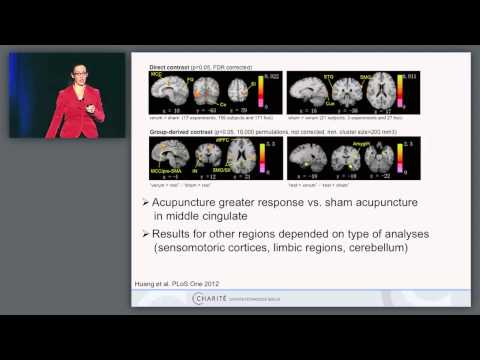So moving into a totally different area–neuroimaging– and this is a slip which shows the increase of studies on neuroimaging on acupuncture. And as you can see in 2009, we roughly had 30 booklets and more than half of them came from China mainland. And as “youre seeing” now that’s a situate, that’s Vitaly Napadov from Harvard University training a patient for the scan. So we thought it a good opinion to do a systematic asses on fMRI look investigates. After we started this, and it made us two and a half years, we were not anymore sure if this was a really good opinion, because it get so complicated. We felt roughly 150 investigates in English, many of them in Chinese, some of them in Japanese, some of them in Korean, and you see from all other groups that this was really covered by the group. And the results of this work was principally to be undertaken by my Chinese Ph.D. student Wenjing Huang. And these are long tables, this is just published in April, but these tables give you nice informed about all these investigates and which areas you envision anything happening in the brain.
And these are the main areas now from the systematic asses. Then we moved the entire thing to Plus One, and one of the reviewers came back to us and spoke, “Oh, there is this new practice of doing meta-analysis on fMRI investigates. Delight do a meta-analysis.” So we spoke “Oh my gosh, now we still have also to do a meta-analysis.” We did a meta-analysis, we had the cooperation partners at the Max Planck Institute in Leipzig and they had done one before. And we felt 34 of the booklets had the data we needed to do a real meta- analysis on fMRI studies.
And we even had to do two of them since data was different. We had data which was on the group height, and we had data which was only the different in the groups, so that it was necessary to do two different meta-analyses now. And these are the results of the meta-analysis and it was quite heterogeneous what came up there in the different ways of doing the meta-analysis. There was one thing which was clear and homogenous, that acupuncture had a greater answer than sham acupuncture in the middle cingulate. We always received certain differences between acupuncture and sham acupuncture but it depended on the type of meta-analysis, and you see here different other areas.
So the data is highly heterogeneous, which is out at the moment. The data is not so much high quality. And now I really can say we need more high quality investigates. And for example the group in Harvard is also standing for high quality investigates, but we also need the information contained in the booklets that is presented in a way that you can really use it for meta-analysis, so that the updating of this kind of meta- s 54 00:03: 04,467 –> 00:03: 07,267 analysis are possible in the future. We envision different in acupuncture and sham acupuncture. A totally different question which I always had is the influence of manual stimulation. You have envisioned when George Lewis in the film did acupuncture on individual patients he turned the needle.
This kind of manual stimulation is often always done in the acupuncture group. It’s usually roughly never done in the sham group when you do research studies. So how does stimulation alone affect some of the data. And we have employed now a representation of gastric slow ripples. And the relevant recommendations behind is that motoric work is regulated by the autonomic nervous system and with electrical pacemaker you can appraise these gastric slow-paced waves.
And the primary outcome here was percentage points of regular gastric slow-paced ripples, the so-called normogastria. And we did it with healthful volunteers, we employed stomach 36 and pericard 6 as acupuncture times. We had a sham part now on the upper arm and we had a stimulated acupuncture group. We had acupuncture group without stimulation and we had a sham acupuncture group without stimulation. And these are the results. So we received no distinction between acupuncture and sham acupuncture in our representation. But we felt now substantial gap and relevant discrepancies between stimulated and non-stimulated acupuncture.
So at least in the situate stimulation matters and this might be something “weve got to” dig in a bit deeper in future study ..
